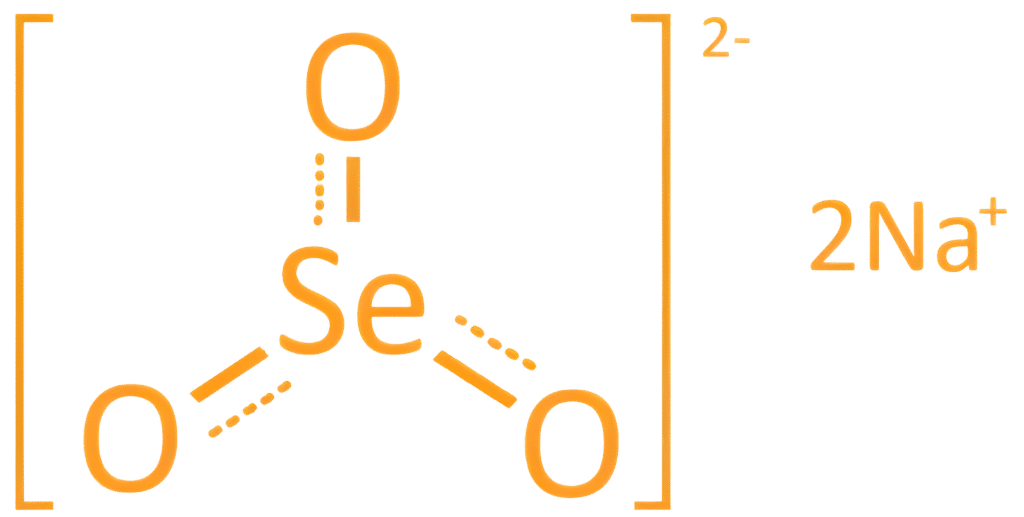Navigation: Stack Index | Vitamins | Minerals | Supplements

Selenium is a trace mineral that punches well above its weight. Found in small amounts in foods like Brazil nuts, seafood, and whole grains, it’s a cornerstone of cellular resilience. It shields your cells from oxidative stress, powers thyroid function, supports DNA repair, and keeps your immune system sharp.
- Functions & Mechanism
- Food Sources vs Supplementation
- How to Use (Dosing & Timing)
- Tactical Stacks
- Signs of Deficiency
- Risks & Safety
- Who It’s For
- Who Should Be Cautious
- What Biohackers Get Wrong
- References & Further Reading
Bodybuilders have long leaned on selenium as part of their pre-competition routines. Optimized levels help support healthy, resilient skin and strong, glossy hair, giving the body a polished, “stage-ready” look.
In this guide, we break down exactly why selenium matters, how it supports cellular repair, thyroid power, and antioxidant defense, and how to get it right — without overdoing it. Master this mineral, and you’re not just surviving; you’re setting the stage for long-term health, performance, and unstoppable vitality.
Functions & Mechanism
Selenium operates as a cofactor in critical enzymes known as selenoproteins. These regulate oxidative stress, cellular defense, and metabolic signaling:
- Glutathione peroxidase (GPx): Neutralizes hydrogen peroxide and lipid peroxides, protecting mitochondria and membranes from damage.
- Thyroid hormone activation: Selenium-dependent deiodinases convert T4 into active T3, supporting energy, fat-burning, and mood.
- DNA repair and anti-aging: Selenoproteins help maintain genomic stability and limit chronic inflammation.
- Immune optimization: Selenium supports antiviral defense and modulates immune overactivation.
Food Sources vs Supplementation
Whole Food Sources
- Brazil nuts: 1–2 nuts can meet daily needs
- Yellowfin tuna, sardines, and salmon
- Beef, turkey, and chicken
- Eggs and mushrooms
- Sunflower seeds and oats (moderate levels)
Supplementation
Two primary forms used in supplements:
- Selenomethionine: Highly bioavailable, stored in body proteins
- Sodium selenite: More immediate activity but less storage capacity
Because selenium has a narrow safety window, dosage precision matters. Food-first is often ideal, with supplementation used tactically.
How to Use (Dosing & Timing)
| Context | Typical Dose |
|---|---|
| RDA – Men & Women | 55 mcg/day |
| Optimal performance range | 100–200 mcg/day (from all sources) |
| Upper intake limit | 400 mcg/day (long-term use not recommended) |
- Best taken with food to support absorption and prevent nausea.
- Avoid pairing with high doses of vitamin C, which may reduce selenium absorption.
- If supplementing, cycle with 4–6 week periods, especially at doses over 100 mcg/day.
Tactical Stacks
| Goal | Stack & Rationale |
|---|---|
| Thyroid Activation | Selenium + Iodine + Zinc — supports T4 to T3 conversion, thyroid hormone synthesis, and receptor sensitivity. |
| Oxidative Shielding | Selenium + Vitamin E + CoQ10 — protects mitochondria and muscle membranes under oxidative stress. |
| Immune Fortification | Selenium + NAC + Vitamin D3 — reduces inflammation and supports antiviral immune defense. |
Signs of Deficiency
- Fatigue or poor thyroid function (low T3)
- Increased oxidative stress or inflammation markers
- Weakened immunity or frequent viral infections
- Brain fog and poor thermoregulation
- Muscle pain or weakness (rare but possible)
Risks & Safety
Too Little
- Linked to Hashimoto’s thyroiditis and thyroid dysfunction
- Higher susceptibility to viral infections
- Accelerated oxidative damage and mitochondrial fatigue
Too Much
- Can cause selenosis (overload toxicity): symptoms include garlic breath, nausea, brittle hair, nail loss, and nervous system issues
- Long-term overdose may impair insulin signaling and thyroid health
Best Practices
- Aim for 100–150 mcg/day from food and supplement sources combined
- Use Brazil nuts mindfully — selenium content varies widely per nut
- Cycle supplements to avoid buildup in tissues
Who It’s For
- People with sluggish thyroid function or low T3
- High-performers exposed to chronic stress or oxidative load
- Athletes needing antioxidant protection for recovery
- Biohackers targeting mitochondrial health and immune resilience
Who Should Be Cautious
- People consuming high levels of selenium-rich foods (e.g. Brazil nuts daily)
- Those taking high-dose multivitamins with selenium and not tracking intake
- Individuals with autoimmune thyroid conditions (require medical supervision)
What Biohackers Get Wrong
- Overdosing on Brazil nuts thinking more is better — can easily exceed 400 mcg/day
- Ignoring selenium’s synergistic relationship with iodine and zinc
- Taking selenium long-term without cycling or testing
- Neglecting the role of selenium in viral immunity and mitochondrial detox
References & Further Reading
- NIH ODS: Selenium – Fact Sheet for Health Professionals
- Selenium and Selenoproteins in Health (Antioxidants, 2017)
- What Selenium Is and Why You Need It (But Not Too Much of It)
- This Underrated Nutrient May Help Lower Heart Disease Risk by 16%
Disclaimer: This article is for educational purposes only and is not medical advice. Always consult with a healthcare provider before starting or modifying any supplementation protocol, especially with trace minerals.
Navigation: Stack Index | Vitamins | Minerals | Supplements